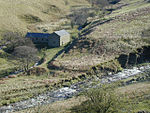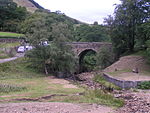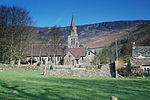Dark Peak

The Dark Peak is the higher and wilder part of the Peak District in England, mostly forming the northern section but also extending south into its eastern and western margins. It is mainly in Derbyshire but parts are in Staffordshire, Cheshire, Greater Manchester, West Yorkshire and South Yorkshire. It gets its name because (in contrast to the White Peak), the underlying limestone is covered by a cap of Millstone Grit sandstones with softer shale underneath, meaning that in winter the soil is almost always saturated with water. The land is thus largely uninhabited moorland plateaux where almost any depression is filled with sphagnum bogs and black peat. The High Peak is an alternative name for the Dark Peak, but High Peak is also the name of an administrative district of Derbyshire which includes part of the White Peak. The areas of Millstone Grit form an 'inverted horseshoe' around the lower uncapped limestone areas of the White Peak, enclosing it to the west, north and east. Hence the Dark Peak is said to cover the higher, northern moors between the Hope Valley to the south and the Tame Valley, Standedge and Holme Valley to the north, separating it from the South Pennines, the Western Moors stretching south to near the Churnet Valley, and the Eastern Moors southwards towards Matlock. The Dark Peak is one of 159 National Character Areas defined by Natural England; as defined by Natural England, the Dark Peak NCA covers 86,604 hectares (334 sq mi) and includes the northern block of hills approximately bounded by Marsden, Stocksbridge, Hathersage and Chapel-en-le-Frith, plus the eastern moors between Hathersage and Matlock, but excludes the western moors between Chapel and the Churnet Valley (which it places in NCA 53, the South West Peak), and the area around Glossop (in NCA 54, Manchester Pennine Fringe).An area of 31,852 hectares (123 sq mi) is designated as the Dark Peak Site of Special Scientific Interest (SSSI), which excludes the separately designated Eastern Moors. The SSSI extends over the borders into Greater Manchester and West Yorkshire. A large part of the SSSI is included in the South Pennine Moors Special Area of Conservation.Principal upland areas within the Dark Peak include Kinder Scout, Bleaklow (both of which rise to over 600 m (2,000 ft)), Black Hill, the Roaches, Shining Tor, Mam Tor, Win Hill and Stanage Edge.
Excerpt from the Wikipedia article Dark Peak (License: CC BY-SA 3.0, Authors, Images).Dark Peak
Snake Road, High Peak Hope Woodlands
Geographical coordinates (GPS) Address Nearby Places Show on map
Geographical coordinates (GPS)
| Latitude | Longitude |
|---|---|
| N 53.4 ° | E -1.8 ° |
Address
Snake Road
Snake Road
S33 0AB High Peak, Hope Woodlands
England, United Kingdom
Open on Google Maps











